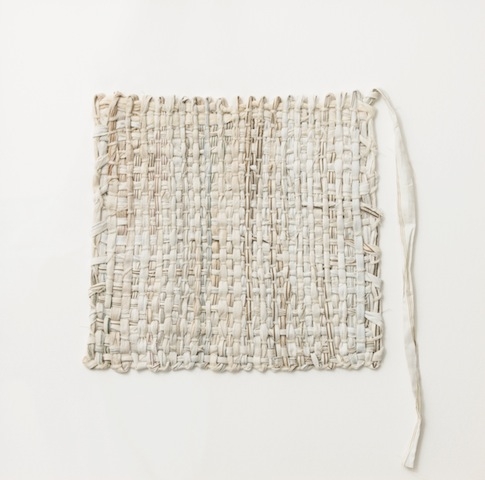Alison Jacques Gallery, London, 4 October – 11 November
Sheila Hicks’s star is firmly in the ascendant. From the 15-metre-wide Escalade Beyond Chromatic Lands (2016–17) in Viva Arte Viva at the Venice Biennale, to the 200-metre-long Hop, Skip, Jump, and Fly: Escape From Gravity (2017) snaking along New York’s High Line, the octogenarian artist’s installations seem to be cropping up everywhere. The show at Alison Jacques Gallery (Hicks’s second) spotlights a more modest strand of her artmaking. Still, the gallery is dominated by the sculptural presence of Grande Boules (2009): a cluster of riotously colourful pouffe-like pieces, reminiscent of wholesale bales of yarn. They are vibrantly, joyously tawdry; metallic strands glint through a grab-bag assortment of thread. Suspended nearby is I am at the Gate (2017): thick skeins of golden yellow nearly three-metre-high hang down, Rapunzel-like. These large works recall the accidental beauty of some arrangement glimpsed on a textile factory’s floor, recalling Hicks’s assertion: ‘If you keep your eyes open, you’re going to have a hell of a time.’
When Hicks ignores her own adage, the result is slicker, more minimal – and overall, less engaging. Langue d’Oiseau II (2016–17), a big woven panel of red and orange bands, resembles nothing so much as Rothko reinterpreted by Habitat. It wouldn’t appear out of place in a tasteful corporate lobby – and, as if to suggest so, it’s been placed in the foyer. Elsewhere, patterns skitter and fall out of line; stray filaments offer nuance in otherwise well-behaved works and orderly strands are pleasingly disrupted. Thickly bound tendrils of forest-green peek through tidy threads of saffron yellow and orange in Torsade Orange (2015). The effect is to encourage you to look closely and consciously.
are the large pieces a pre-emptive retort against readings of this work as craft only?
That being said, there’s a perceptible tension between the different demands Hicks’s larger and smaller-scale works make in the gallery space. Gigantism doesn’t encourage enjoyment of the tactile details of tone and texture (which are, broadly speaking, some of fibre art’s most compelling qualities) – in fact, it hinders it, encouraging a step backward rather than forward. Is the inclusion of the large pieces a pre-emptive retort against readings of this work as craft only? At the other end of the spectrum is Hicks’s career-long Minimes series: small, framed weavings made in response to trips in Africa, Asia and South America. Their size, flatness and presentation render them more pictorial than other works, while the scale – each comparable to the page of a diary – invites intimacy and close observation. And, overall, they repay this attention. Back from the Front, “TUV” (2017) harnesses sashiko, a Japanese stitching technique, in an exuberantly haphazard fashion. Porcupine quills adorning Ensemble (2003) render the textile reminiscent of a memento picked up on holiday. A small striped feather insinuates itself into the weft of As If I Did Not Know (2015–16) like a chance encounter. These diminutive works speak eloquently of Hicks’s experiences of travel.
Humblest of all is Shaker (2017), a grid of faded scraps from an old man’s shirt, inspired by the make-do-and-mend culture of eighteenth-century Shaker communities. Nearly unravelling, it wavers but holds fast. The humility is touching. For all the large-scale projects worldwide, it’s good to see that the grande dame of fibre art still appreciates the small things.
From the December 2017 issue of ArtReview
